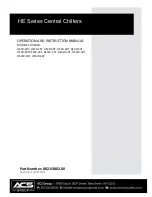
Unit Shutoff —
To shut unit off, move LOCAL/ENABLE-
STOP-CCN switch to STOP position. Any refrigeration cir-
cuit operating at this time continues to complete the pum-
pout cycle. Lag compressors stop immediately, and lead
compressors run to complete pumpout.
Complete Unit Stoppage —
Complete unit stoppage
can be caused by any of the following conditions:
1. Cooling load satisfied
2. Remote on/off contacts open
3. Programmed schedule
4. Emergency stop command from CCN
5. General power failure
6. Blown fuse in control power feed disconnect
7. Open control circuit fuse
8. LOCAL/ENABLE-STOP-CCN switch moved to STOP
position
9. Freeze protection trip
10. Low flow protection trip
11. Open contacts in chilled water flow switch (optional)
12. Open contacts in any auxiliary interlock. Terminals that
are jumpered from factory are in series with control switch.
Opening the circuit between these terminals places unit
in stop mode, similar to moving the control switch to
STOP position. Unit cannot start if these contacts are
open. If they open while unit is running, unit pumps down
and stops.
13. Cooler entering or leaving fluid thermistor failure
14. Low transducer supply voltage
15. Loss of communications between processor module and
other control modules
16. Low refrigerant pressure
17. Off-to-on delay is in effect.
Single Circuit Stoppage —
Single circuit stoppage
can be caused by the following:
1. Low oil pressure in lead compressor
2. Open contacts in lead compressor high-pressure switch
3. Low refrigerant pressure
4. Thermistor failure
5. Transducer failure
6. Ground fault in lead compressor indicator (indicator is
field-supplied on 040-060, 070 [60 Hz], and 080-110 and
associated modular units)
7. High suction superheat
8. Low suction superheat
9. Lead compressor circuit breaker trip. Stoppage of one
circuit by a safety device action does not affect other
circuit. When a safety device trips on a lead compres-
sor, circuit is shut down immediately and EXV closes.
10. Ground fault for any circuit compressor (130-210 and
associated modular units).
Lag Compressor Stoppage —
Lag compressor stop-
page can be caused by the following:
1. Open contacts in high-pressure switch
2. Compressor ground fault (indicator is field-supplied on
040-060, 070 [60 Hz], and 080-110 and associated modu-
lar units)
3. Compressor circuit breaker trip
4. Not required to run to meet cooling load requirement
If stoppage occurs more than once as a result of any of
the above safety devices, determine and correct the cause
before attempting another restart.
Restart Procedure —
After cause for stoppage has been
corrected, restart is either automatic or manual, depending
on fault. Manual reset requires that LOCAL/ENABLE-
STOP-CCN switch be moved to STOP position, then back
to original operating position. Some typical fault conditions
are described in Table 15. For a complete list of fault con-
ditions, codes, and reset type, see Table 16.
Table 15 — Typical Stoppage Faults and Reset Types
Chilled Fluid, Low Flow
Manual reset
Chilled Fluid, Low Temperature
Auto reset first time, manual
if repeated in same day
Chilled Fluid Pump Interlock
Manual reset
Control Circuit Fuse Blown
Unit restarts automatically when
power is restored
High-Pressure Switch Open
Manual reset
Low Refrigerant Pressure
Auto reset first time, then
manual if within same day
Low Oil Pressure
Manual reset
Discharge Gas Thermostat Open Manual reset
POWER FAILURE EXTERNAL TO THE UNIT — Unit
restarts automatically when power is restored.
Alarms and Alerts —
These are warnings of abnormal
or fault conditions, and may cause either one circuit or the
whole unit to shut down. They are assigned code numbers as
described below. These code numbers are displayed
on the HSIO when the
subfunction is entered. A
fault that affects one one circuit of the chiller will generate
an alert, and a fault that affects the entire unit will generate
an alarm.
Following is a detailed description of each alarm and alert
code error and possible cause. Manual reset is accomplished
by moving LOCAL/ENABLE-STOP-CCN Switch to STOP
position, then back to LOCAL or CCN position. See
Table 16 for listing of each alarm and alert code.
Code 0
No alarms or alerts exist
Codes 1 - 8
Compressor failure
If DSIO-LV or -EXV relay module control relay feedback
switch or signal is sensed as open during operation of a com-
pressor, microprocessor detects this and stops compressor,
energizes alert light, and displays a code of 1, 2, 3, 4, 5, 6,
7, or 8 depending on the compressor. Compressor locks off;
to reset, use manual reset method.
If lead compressor in a circuit shuts down, the other com-
pressors in the circuit stop and lock off. Only the alert mode
for lead compressor is displayed.
The microprocessor is also programmed to indicate com-
pressor failure if feedback terminal on DSIO-LV or -EXV J3
terminal strip receives voltage when compressor is not sup-
posed to be on.
NOTE: It takes 5 seconds for the control to generate the alarm
code and lock out the compressor(s) on compressor failure
code(s) 1 through 8.
48
Содержание Flotronic II 30GN040
Страница 71: ......
















































